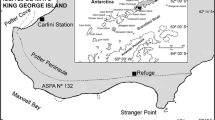Abstract
A total of 41 faeces and 5 vomits of the Weddell seal Leptonychotes weddelli was collected at Harmony Point, Nelson Island, South Shetland Islands, from 14 January to 1 February 1996. The diet indicated by the remains in the samples was diverse and comprised both pelagic and benthic-demersal species. Fish were the most frequent (95.7%) and numerous prey (46.2%), but molluscs were the most important by mass (65.8%). Octopods, mainly Pareledone charcoti, constituted the bulk of the diet (63.1% by mass), but the importance of the remaining molluscs was negligible. Otoliths represented 510 fish of which 491 were identified as belonging to 5 species: Gymnoscopelus nicholsi, Electrona antarctica, Lepidonotothen nudifrons, Gobionotothen gibberifrons and Nototheniops nybelini. The myctophid Gymnoscopelus nicholsi was the most important fish prey, and the contribution of benthic-demersal species was low. However, the importance of that fish was over-estimated since 96% of the specimens were obtained from the five vomits analysed. The biases associated with the faecal analysis technique are discussed.
Similar content being viewed by others
Author information
Authors and Affiliations
Additional information
Received: 3 July 1996 / Accepted: 2 June 1997
Rights and permissions
About this article
Cite this article
Casaux, R., Baroni, A. & Carlini, A. The diet of the Weddell seal Leptonychotes weddelli at Harmony Point, South Shetland Islands. Polar Biol 18, 371–375 (1997). https://doi.org/10.1007/s003000050202
Issue Date:
DOI: https://doi.org/10.1007/s003000050202




